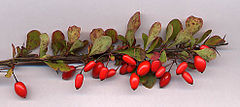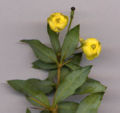Berberis
| Berberis | |
|---|---|

| |
| Berberis darwinii shoot with flowers | |

| |
| Berberis thunbergii shoot with fruit | |
| Scientific classification | |
| Kingdom: | |
| Division: | |
| Class: | |
| Order: | |
| Family: | |
| Genus: | Berberis |
| Species | |
|
About 450-500; see text | |
Berberis (Template:Pron-en Bér-be-ris),[1] the barberries or pepperidge bushes, is a genus of about 450-500 species of deciduous and evergreen shrubs from 1-5 m tall with thorny shoots, native to the temperate and subtropical regions of Europe, Asia, Africa, North America and South America. They are closely related to the genus Mahonia, which is included within Berberis by some botanists.
The plant
The genus is characterised by dimorphic shoots, with long shoots which form the structure of the plant, and short shoots only 1-2 mm long. The leaves on long shoots are non-photosynthetic, developed into three-spined thorns 3-30 mm long; the bud in the axil of each thorn-leaf then develops a short shoot with several normal, photosynthetic leaves. These leaves are 1-10 cm long, simple, and either entire, or with spiny margins. Only on young seedlings do leaves develop on the long shoots, with the adult foliage style developing after the young plant is 1-2 years old.
The deciduous species (e.g. Berberis thunbergii, B. vulgaris) are noted for good autumn colour, the leaves turning pink or red before falling. In some evergreen species from China (e.g. B. candidula, B. verruculosa), the leaves are brilliant white beneath, making them particularly attractive.
The flowers are produced singly or in racemes of up to 20 on a single flower-head. They are yellow or orange, 3-6 mm long, with six sepals and six petals in alternating whorls of three, the sepals usually coloured like the petals. The fruit is a small berry 5-15 mm long, ripening red or dark blue, often with a pink or violet waxy surface bloom; they may be either long and narrow (like a bar, hence 'barberry') or in other species, spherical.
Berberis species are used as food plants by the larvae of some Lepidoptera species including Mottled Pug.
Several are popular garden shrubs, grown for their ornamental leaves, yellow flowers, and red or blue-black berries. They are also valued for crime prevention; being very dense, viciously spiny shrubs, they make very effective barriers impenetrable to burglars. For this reason they are often planted below potentially vulnerable windows, and used as hedges and other barriers.
Historically, yellow dye was extracted from the stem, root, and bark.[2]
Berberis vulgaris (European barberry) is the alternate host species of the wheat rust Puccinia graminis, a serious fungal disease of wheat. For this reason, cultivation of this species is prohibited in many areas.
Some Berberis have become invasive species when planted outside of their native ranges, including B. glaucocarpa and B. darwinii in New Zealand (where it is now banned from sale and propagation), and B. thunbergii in some parts of North America.
Culinary uses
The berries are edible, and rich in vitamin C, though with a very sharp flavour; the thorny shrubs make harvesting them difficult, so in most places they are not widely consumed. They are an important food for many small birds, which disperse the seeds in their droppings.
A widely available Ukrainian candy called Барбарис (Barberis) is made using extract from the berries, which are pictured on the wrapper.
Calafate
Berberis microphylla or Berberis heterophylla (Calafate) and Berberis darwinii (Michay) are two species found in Patagonia in Argentina and Chile. Their edible purple fruits are used for jams and infusions; anyone who tries a berry is said to be certain to return to Patagonia. The calafate and michay are symbols of Patagonia.
Zereshk
Zereshk (زرشک) is the Persian name for the dried fruit of Berberis vulgaris, which are widely cultivated in Iran. Iran is the largest producer of zereshk and saffron in the world. Zereshk and saffron are produced on the same land and the harvest is at the same time.
The South Khorasan province in Iran is the main area of zereshk and saffron production in the world. Barberry cultivation in Iran is concentrated in the South Khorasan province, especially around Birjand and Qaen. About 85% of production is in Qaen and about 15% in Birjand. According to evidence the cultivation of seedless barberry in South Khorasan goes back to two hundred years ago.[3]
A garden of zereshk is called zereshk-estan.
Zereshk is widely used in cooking, imparting a tart flavor to chicken dishes. It is usually cooked with rice, called zereshk poloRecipe, and provides a nice meal with chicken. Zereshk jamphoto, zereshk juicephoto, and zereshk fruit rollsphoto are also produced in Iran.
In colloquial Persian, zereshk is used as a term for showing dissent or disagreement, similar to the usage of "blowing a raspberry" in English. Although not a vulgar term in that context, it is not used in polite speech.[citation needed]
Selected species
Gallery
-
Berberis gagnepainii three-spined thorn (modified long shoot leaf) with leafy short shoot. Each thorn is 20 mm long.
-
Berberis verruculosa upper side of shoot above, lower side below.
-
Berberis gagnepainii flower detail (flowers 7 mm diameter).
-
Berberis gagnepainii fruit.
-
Berberis thunbergii shrub.
-
Berberis aristata from the Himalayas
References
- ^ Sunset Western Garden Book, 1995:606–607
- ^ Tomlinson, C., ed. (1866). Tomlinson's Cyclopaedia of Useful Arts. London: Virtue & Co.
{{cite book}}:|author=has generic name (help)CS1 maint: multiple names: authors list (link) Vol I, page 97. - ^ BARBERRY GROWING IN IRAN,http://www.actahort.org/members/showpdf?booknrarnr=620_21
- Murrills, Angela (2005-11-24). "Best Eating: Check, please". Straight.com. Retrieved 2007-05-02.
{{cite web}}: Cite has empty unknown parameter:|coauthors=(help)
- Wilkinson, Bobbie (2004-08-15). "It's an Adventure in Persian Cuisine at Darya Kabob". The Washington Post. Retrieved 2007-05-02.
{{cite web}}: Unknown parameter|coauthors=ignored (|author=suggested) (help)
- Arellano, Gustavo (2004-03-18). "Naan & Kabob". Orange County Weekly. Retrieved 2007-05-02.
{{cite web}}: Cite has empty unknown parameter:|coauthors=(help) - Royal New Zealand Institute of horticulture. Berberis glaucocarpa
External links
- Berberine Thoughts – Informative but non-scholarly essay on barberry and Berberis (culture, history and etymology)
See also
Zereshk
- Picture of packaged Berberis fruit (Zereshk) as sold in Iran and in the US.








